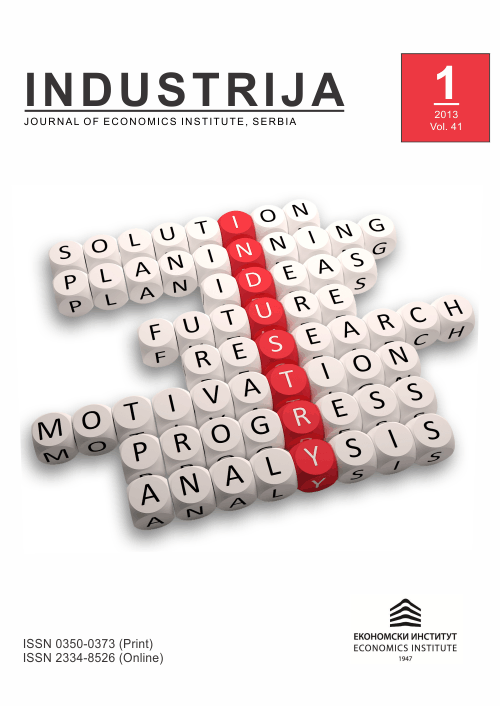The differences in job satisfaction among employees in public and private enterprises in Serbia
Abstract
The aim of this paper is to show the sector differences in job satisfaction among employees in Serbian enterprises. Based on the empirical and theoretical findings, it was shown that the employees in public enterprises in Serbia are more satisfied with their job than their counterparts in the private sector, which presents a general trend characteristic of countries where research of this type was carried out. In addition, it was pointed out to the general trend in preference of the employment of employees in public enterprises, that is, the abandonment of the private sector of the economy. It was shown that the effects of the economic crisis in the country, together with incomplete adjustment to the new market conditions in the field of labour and employment relations, determine job certainty as one of the most important factors in shaping employee satisfaction which contributes to decision making about staying in or leaving an organization.
References
Public service?, No, thanks, I am an entrepreneur. (2012). Belgrade. Citizens' initiatives.
Labour force survey for 2010. (2011). Beograd: The statistical office of the Republic of Serbia.
Clark, A.E., & Senik, C. (2006). The (unexpected) structure of “rents” on the French and British labour markets. Journal of Socio-Economics, 35(2), 180-196. doi:10.1016/j.socec.2005.11.010
Clark, A.E. (2001). What really matters in a job?, Hedonic measurement using quit data. Labour Economics, 8, 223-242. Audit Commission, 2002. Recruitment and retention: a public service workforce for the twenty-first century. Retrieved from http://www.audit-commission.gov.uk/reports
Clark, A.E., & Postel-Vinay, F. (2009). Job Security and Job Protection. Oxford Economic Papers, 61(2), 207-239.
Demoussis, M., & Giannakopoulos, N. (2007). Exploring Job Satisfaction in Private and Public Employment: Empirical Evidence from Greece. Labour, 21(2), 333-359. doi:10.1111/j.1467-9914.2007.00370.x
Ghinetti, P. (2006). The Public-Private Job Satisfaction Differential in Italy. Milano: Istituto di Economia dell’Impresa e del Lavoro Facoltà di Economia, Università Cattolica del Sacro Cuore.
Hartley, J., Jacobson, D., Klandermans, B., & van Vuuren, T. (1991). Job insecurity: Coping with jobs at risk. London: Sage Publications.
Herzberg, F., Mausner, B., & Sniderman, B. (1959). The motivation to work. Willey.
Ivancevich, J.M., Olekalns, M., & Matteson, M.T. (1997). Organizational behavior and management. (p. 86). Sydney: Irwin.
Report on small and medium enterprises and entrepreneurship in 2008. (2009). (p. 9). Republic, Belgrade: Ministry for economy and regional development, Republic agency for development of SME and entrepreneurship.
Report on small and medium enterprises and entrepreneurship in 2009. (2009). Republic, Belgrade: Ministry for economy and regional development, agency for development of SME and entrepreneurship.
Judge, T.A., & Watanabe, S. (1994). Individual differences in the nature of the relationship between job and life satisfaction. Journal of Occupational and Organizational Psychology, 67(2), 101-107. doi:10.1111/j.2044-8325.1994.tb00554.x
Kanellopoulos, C.N. (1997). Public-private wage differentials in Greece. Applied Economics, 29(8), 1023-1032. doi:10.1080/000368497326417
Kates, S.L. (1950). Rorschach responses, Strong blank scales, and job satisfaction among policemen. Journal of Applied Psychology, 34(4), 249-254. doi:10.1037/h0057747
Kioulafas, K., Donatos, G., & Michailidis, G. (1991). Public and private sector wage differentials in Greece,. International Journal of Manpower, 12, 9-14.
Kreitner, R., Kinicki, A., & Buelens, M. (1999). Organisational behaviour. Berkshire: McGraw Hill..
Luechinger, S., Meier, S., & Stutzer, A. (2008). Bureaucratic Rents and Life Satisfaction. Journal of Law, Economics and Organization, 24(2), 476-488.
Matanović, J. (2009). Osobine ličnosti kao prediktori zadovoljstva poslom. Primenjena psihologija, 2(3), 327-338.
Nathan, A., Bowling, G., & Hammond, D. (2008). A meta-analytic examination of the construct validity of the Michigan Organizational Assessment Questionnaire Job Satisfaction Subscale. Journal of Vocational Behavior, 73(1), 63-77.
Papapetrou, E. (2006). The unequal distribution of the public-private sector wage gap in Greece: evidence from quantile regression. Applied Economics Letters, 13(4), 205-210. doi:10.1080/13504850500393063
Kalleberg, A.L., & Kluegel, J.R. (1975). Analysis of the multitrait-multimethod matrix: Some limitations and an alternative. Journal of Applied Psychology, 60(1), 1-9. doi:10.1037/h0076267
Sverke, M., & Hellgren, J. (2002). The nature of job insecurity: Understanding employment uncertainty on the brink of a new millennium. Applied Psychology: An International Review, 51, 23-42.
Labour Law of the Republic of Serbia. Official Gazette, (2005). 24/05 and 54/09.
Weiss, H.M. (2002). Deconstructing job satisfaction. Human Resource Management Review, 12(2), 173-194. doi:10.1016/S1053-4822(02)00045-1
Retrieved from http://www.tnsmediumgallup.co.rs/newsletters/Newsletter_TNSMediumGallup_Sigurnost%20posla_Jan_08.pdf

